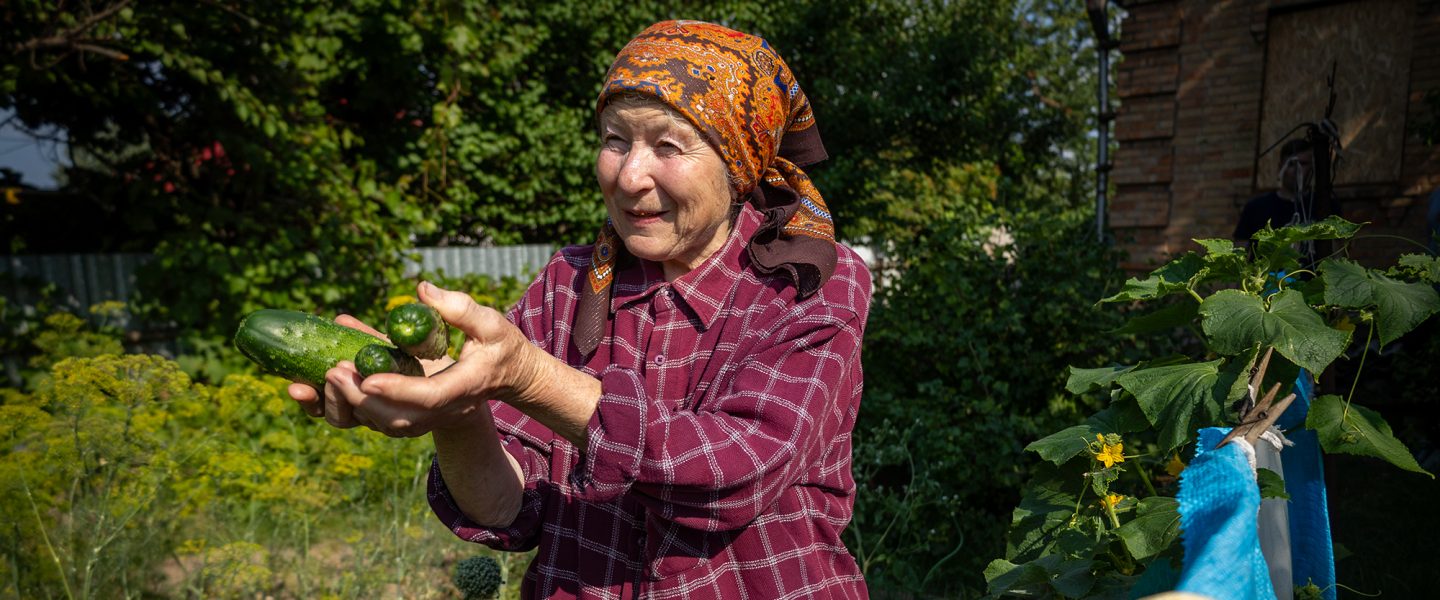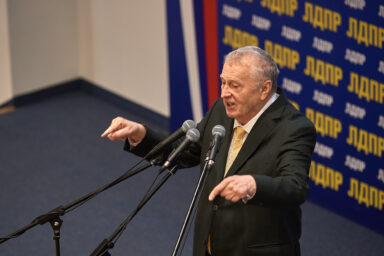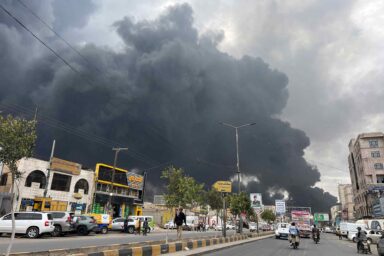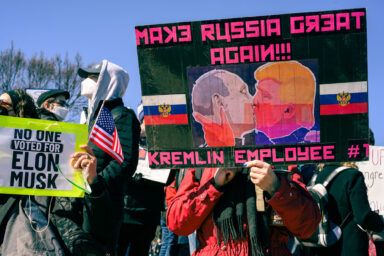In the southern Ukrainian town of Nikopol, residents deal with a severe water shortage, occasional artillery fire, and warnings of a potential nuclear catastrophe.
|
Listen To This Story
|
NIKOPOL, Ukraine — In her sleep, Angelina dreams of nuclear disaster. But when she wakes, the 19-year-old has more immediate problems.
Like most people in the southern front-line town of Nikopol, Angelina hasn’t had running water for about four weeks. The destruction of the Kakhovka dam last month, which Ukraine blamed on Russia, has created a severe water shortage along the upstream reservoir.
“It’s very uncomfortable,” Angelina said earlier this week. “You can’t do many things without water.”
The water shortage has complicated daily life and heightened the possibility of a nuclear disaster at the nearby Zaporizhzhia Nuclear Power Plant (ZNPP). The largest nuclear power plant in Europe, the ZNPP relied heavily on the now drained Kakhovka Reservoir along the Dnieper River for water to cool the plant and prevent a meltdown. For the time being, the water situation appears stable, thanks to alternate sources of water having been secured. Still, concerns of a nuclear disaster deepened in recent weeks as Ukrainian officials warned that Russia was planning to attack the plant.
“We just try not to panic,” Angelina said.
But with each passing day, the possibility of some sort of catastrophe — either deliberate or unintentional — seems to grow.
The Water Shortage

Ana cried when the Kakhovka Reservoir dried up.
The 81-year-old life-long Nikopol resident loved the Dnieper River’s sandy banks and water that sparkled on sunny days. Now, the reservoir sits almost barren. Streaks of brown riverbed cut through small bodies of water, creating something of a no man’s land several miles wide between Ukrainian and Russian forces.
“The thing is that I like Nikopol so much,” Ana said while standing beside her home earlier this week. “I like my street, my town. That is why I am still living here. I have never been somewhere before. Nikopol has so many beautiful places.”
The UN reported in late June that the reservoir had lost 75 percent of its water, leaving an estimated 210,000 people in Nikopol and surrounding areas in dire straits. Local authorities and NGOs stepped in to meet the need, establishing water distribution points and in some cases digging wells. The head of the military administration of the Dnipropetrovsk region, where Nikopol is located, said Monday that more than 14,000 tons of water has been distributed.
Earlier this week, Ana headed to one distribution point near the Dnieper River in Nikopol to collect water to garden her plants. She wheeled a small cart loaded with old water jugs through a quiet neighborhood and filled them from a water tank. A small group of international aid workers passing the site drove her back home. Ana usually carted the jugs herself along paved and unpaved roads to her home a few miles away. It is a tiring task for her, and she expressed gratitude to the aid workers for providing the ride.
“I am already an elderly person, and it is difficult for me to do something because I am alone,” Ana told the aid workers. Her husband passed away 30 years ago and she has no children. That day, she collected water for gardening, washing clothes, and showering. Every other day, she goes to a local school to get drinking water.

Unlike some other cities and towns along Ukraine’s front line, Nikopol has not been destroyed or heavily bombed. Still, Russian forces on the other side of the Dnieper regularly fire artillery at the town. Though the attacks continue to terrify Ana, and as difficult as the water shortage may be, she is grateful to have gas for cooking and electricity so that she can watch television.
“God says we have to be patient, so we hope and wait,” she said. “We are waiting for the end of the war. We don’t know when it will be. We have to wait and hope. Hope never dies.”
A Looming Nuclear Crisis?
The ZNPP’s six reactors and two cooling towers, flanked by the Zaporizhzhia Thermal Power Plant, stand tall in the horizon across the Dnieper River. Before Russia invaded Ukraine in February 2022, the plant was an important component of Ukraine’s nuclear industry, contributing to half of the country’s energy needs.
Russian forces seized the plant last March and have used it as a military base, according to Ukrainian officials. Fearing that an accident could occur from artillery fire — and now a lack of water — ZNPP staff shut down the plant’s six reactors.
But many people are still concerned about a nuclear catastrophe, especially in light of the water shortage and recent warnings from Ukrainian officials that Russia is planning to attack the plant.
Like many Ukrainians, Andrii Guziy, the head of a local NGO in Nikopol helping with water distribution, believes it is likely that Russia will attack the ZNPP in the near future.
“Many people are really afraid and leaving the city,” he said. “They go away and take things, take cars, take everything they can and leave.”
Guziy specifically noted a report by Ukraine’s military intelligence last week alleging that Russia had withdrawn staff from the plant and advised Ukrainian employees to leave by July 5. The report also stated that Russia had reduced military patrols around the site and instructed remaining personnel to “blame Ukraine in case of any emergencies.”
The report followed comments from Kyrylo Budanov, the head of Ukraine’s intelligence agency, who said that Russia was planning a “terrorist attack” against the plant, possibly in a bid to hamper or block an ongoing Ukraine counteroffensive in the area. He alleged that Russia had positioned vehicles packed with explosives at four of the plant’s six nuclear reactors and mined a pond filled with water for cooling the site.
In his usual nightly address on Tuesday, Ukrainian President Volodymyr Zelenskyy claimed that Russian troops had set “objects resembling explosives” on the roof of several power units at the plant. He said the apparent explosives could be used “to simulate an attack on the plant” that Russia could blame on Ukraine.
Experts have questioned whether Russia actually would carry out such an attack, noting that radiation leakage would affect its own forces too. Many Ukrainians believe otherwise and suspect Russia of destroying the Kakhovka dam. Those with such views were upset by what they perceived as a weak response from Ukraine’s allies. Zelenskyy touched on such sentiment during his speech Tuesday evening.
“Unfortunately, there was no timely and large-scale response to the terrorist attack on the Kakhovka hydroelectric power plant, and this may incite the Kremlin to commit new evil,” Zelenskyy said. “It is the responsibility of everyone in the world to stop it. No one can stand aside, as radiation affects everyone.”
Russia has denied any intentions to attack the nuclear power plant, and Ukrainian officials have not provided evidence for their claims.

Late last month, the International Atomic Energy Agency (IAEA), which has been overseeing the nuclear power plant, said it had not found any “visible indications of mines or other explosives” there. A few days prior, the White House had said that it was watching the situation “very closely” but hadn’t “seen any indication that that threat is imminent.”
An accident, attack, or human error could lead to a nuclear meltdown at the plant, but there’s dispute about how easy it would be to damage the site’s reactors.
“I don’t think one can make very definitive predictions,” said M.V. Ramana, the Simons Chair in Disarmament, Global and Human Security at the University of British Columbia’s School of Public Policy and Global Affairs.
“Those who designed reactors tend to be a little overconfident of their safety,” he continued. “And others might tend to be a little bit too alarmist.”
Military attack or not, the ZNPP remains vulnerable. On Tuesday morning, the plant lost connection to its main external power line, according to the IAEA. A recently reestablished backup line is now the primary source of electricity crucial for preventing a nuclear accident.
The plant has generators that can be used in the event of an emergency, but a complete loss of electricity would spell disaster as the plant would no longer be able to pump water needed for cooling to prevent a meltdown.
“This is the concern, that even though the reactors are shut down, unless you constantly keep cooling it, the fuel can melt down and start emitting radioactive materials that can be spread out by the wind,” said Ramana.
He and many others remain concerned that human error could cause — or fail to prevent — a nuclear accident at the ZNPP. Some Ukrainian staff remain at the plant, and former employees have described facing abuse, torture, and otherwise extreme stress at work since Russia took over.
Nuclear plant operators have to follow very detailed, specific instructions to keep a nuclear power plant functioning properly, Ramana said. “It’s an open question whether operators who are working in such a stressful place, where everybody is so worried, will actually be operating in the best possible manner.”
Such conditions could impede the ability of employees to properly handle an emergency should one arise, Ramana said.
For the time being, the water situation appears stable. The plant has diversified its sources of water away from the Kakhovka Reservoir, and with the reactors shut down, it needs less water than usual for cooling, said Ramana.
The worst case scenario, according to Ramana, would be an accident involving spent fuel, which is radioactive. Given how long the plant has operated, he said the ZNPP likely has a large stockpile of spent fuel rods. Those rods would be stored under water for cooling. If the water were to drain out, the fuel rods would heat up and, if they are densely packed, catch fire.
“And all of these volatile radionuclides, the ones that can be quickly converted into gas, can spread out,” Ramana said.
Ultimately, it’s unclear what, if anything, will happen. Still, Ukrainian authorities in areas near the ZNPP have been conducting drills and issuing safety instructions in preparation for a disaster.
Whether Angelina and her family will flee or barricade themselves inside their home will depend on the specific circumstances. For her part, Angelina is skeptical that Russia will attack the plant.
“I believe that they are not so stupid,” she said. But then she paused before adding, “I try to believe it.”
At a cafe shortly before sunset on Sunday, life in Nikopol seemed almost normal. About a dozen customers sat at tables, drinking coffee, tea, and juice and eating sandwiches and pastries. Families went for walks. Restaurants and stores around the town remained open.
“We just live and believe that everything will be okay,” Angelina said. “We don’t have any other choice.”
As she spoke, a couple of artillery rounds hit the town. Angelina barely paid attention. For the time being, she has bigger problems to worry about.




